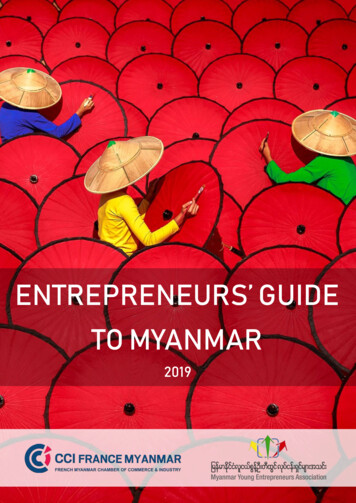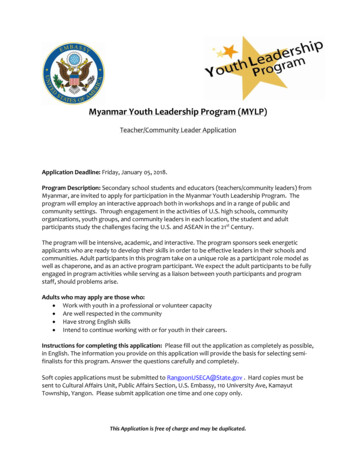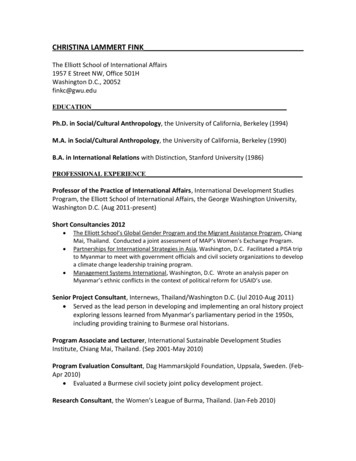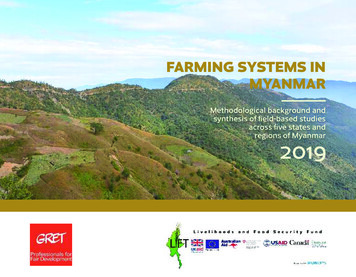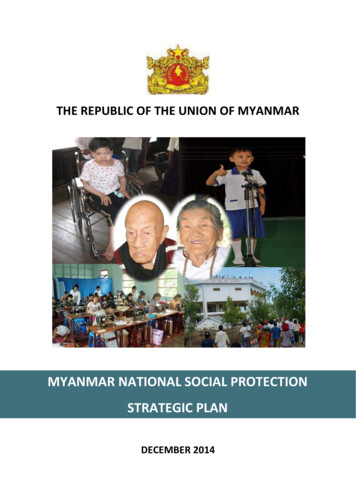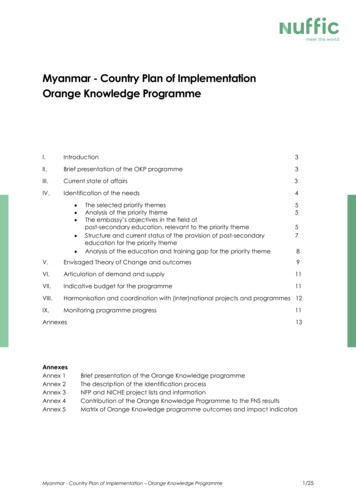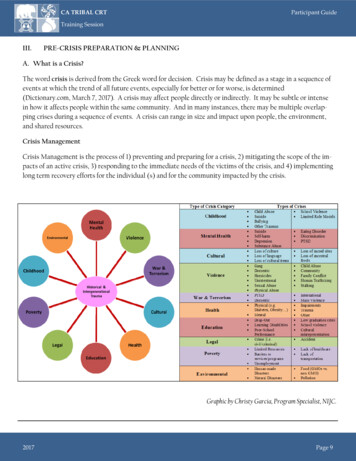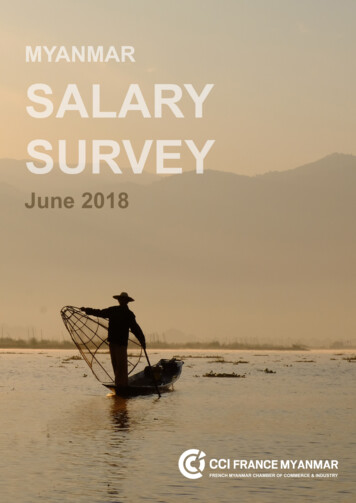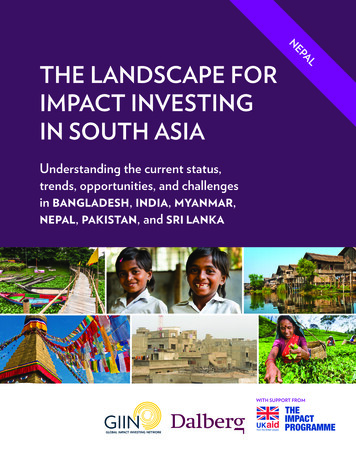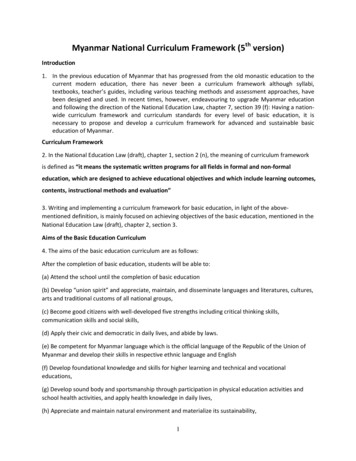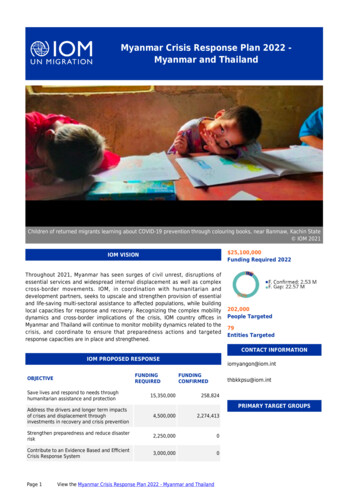
Transcription
Myanmar Crisis Response Plan 2022 Myanmar and ThailandChildren of returned migrants learning about COVID-19 prevention through colouring books, near Banmaw, Kachin State IOM 2021 25,100,000Funding Required 2022IOM VISIONThroughout 2021, Myanmar has seen surges of civil unrest, disruptions ofessential services and widespread internal displacement as well as complexcross-border movements. IOM, in coordination with humanitarian anddevelopment partners, seeks to upscale and strengthen provision of essentialand life-saving multi-sectoral assistance to affected populations , while buildinglocal capacities for response and recovery. Recognizing the complex mobilitydynamics and cross-border implications of the crisis, IOM country offices inMyanmar and Thailand will continue to monitor mobility dynamics related to thecrisis, and coordinate to ensure that preparedness actions and targetedresponse capacities are in place and strengthened.202,000People Targeted79Entities TargetedCONTACT INFORMATIONIOM PROPOSED RESPONSEFUNDINGREQUIREDOBJECTIVESave lives and respond to needs throughhumanitarian assistance and MEDthbkkpsu@iom.int258,824PRIMARY TARGET GROUPSAddress the drivers and longer term impactsof crises and displacement throughinvestments in recovery and crisis prevention4,500,0002,274,413Strengthen preparedness and reduce disasterrisk2,250,0000Contribute to an Evidence Based and EfficientCrisis Response System3,000,0000Page 1View the Myanmar Crisis Response Plan 2022 - Myanmar and Thailand
1.2.3.4.Page 2View the Myanmar Crisis Response Plan 2022 - Myanmar and ThailandInternal migrantInternally displaced personInternational migrantLocal population / community
BREAKDOWN OF FUNDING REQUIREMENTS (USD) 2022OBJECTIVES AND ACTIVITY AREAS2022Save lives and respond to needs through humanitarian assistance and protectionBasic Needs, including Food4,950,000Direct Health Support6,200,000Mental Health and Psychosocial Support in Humanitarian Response500,000Protection1,700,000Provision of Water, Sanitation and Hygiene in Emergencies2,000,000Address the drivers and longer term impacts of crises and displacement through investments in recoveryand crisis preventionCommunity stabilization3,500,000Health System Strengthening1,000,000Strengthen preparedness and reduce disaster riskHealth Components of Preparedness and Risk Reduction1,050,000Points of Entry1,200,000Contribute to an Evidence Based and Efficient Crisis Response SystemDisplacement TrackingTOTAL FUNDING REQUIREDPage 3View the Myanmar Crisis Response Plan 2022 - Myanmar and Thailand3,000,00025,100,000
2022 - Myanmar Crisis Response Plan 2022 - Myanmar andThailandCONTEXT ANALYSISThe ongoing, interlinked crises in Myanmar continue to exacerbate preexisting vulnerabilities and give rise to new multi-sectoral needs,including health, food, water, sanitation and hygiene (WASH),livelihoods and protection. Further, the combined impacts of the politicalcrisis, interruption to essential services, deteriorating security conditionsand the continued spread of COVID-19 in Myanmar and the region haveled to increasingly complex and mixed mobility flows internally andinternationally. As of the end of 2021, OCHA estimates 400,000 havebeen newly displaced across Myanmar due to clashes and insecurity since1 February, in addition to more than 340,000 in situations of protracteddisplacement prior to 2021. In addition, over 70,000 Myanmar migrantshave returned from Thailand since January 2021, with increased irregularmovements between Myanmar and Thailand in recent months. In thecurrent context, protection risks related to gender-based violence,trafficking, exploitation and abuse have increased for migrants anddisplaced populations. Households are struggling to meet their needsafter losing regular sources of income from jobs and remittances, givingrise to increasing levels of debt and use of negative coping mechanismssuch factors and shocks have reversed or severely compromised previousdevelopment gains. Affected populations include individuals facingprotracted and new displacement, internal migrants displaced from periurban areas, Myanmar migrants returning from abroad, host communitiesand migrant-sending/receiving households.With a highly porous border between Thailand and Myanmar that has typically seen dynamic, regular and irregular crossborder flows, movement between the two countries continued in 2021 despite official border closure. Between March andMay 2021, IOM’s mobility monitoring mechanism estimated about 4,000 Myanmar nationals entering Thailand monthly.These numbers reduced to about 2,000 per month between June and August as a result of heightened mobilityrestrictions, increased COVID-19 infections on both sides of the border and challenges crossing the river during the rainyseason. From September 2021, estimated arrivals into Thailand have been increasing again due to the continuingdeterioration of the situation in Myanmar, the gradual reopening of Thailand’s borders and the end of the rainy season.The cross-border movement is expected to remain dynamic and complex as Myanmar nationals represent one of thelargest migrant populations in Thailand. Three million Myanmar nationals were estimated living in Thailand before 2021.In 2022, Thailand estimates requiring about half a million labour migrants to help resume economic activity in line withoverall COVID-19 recovery efforts. This combined with the deteriorating situation in Myanmar, is likely to contribute toincreased mobility between the two countries with many Myanmar nationals arriving in Thailand in search of economicopportunity while others will continue to flee unrest and the deteriorating COVID-19 situation in Myanmar. The ongoingpandemic will further increase the vulnerability of Myanmar nationals and border communities and heighten protectionrisks as irregular crossings are likely to continue in the foreseeable future.COORDINATIONIOM works closely across borders and at regional and sub-regional levels to ensure a coordinated response to the needsof Myanmar migrants. In Myanmar, IOM is an active member of the Humanitarian Country Team and related humanitariancoordination mechanisms at national level, as well as at state and regional levels in Kachin, Rakhine and the South East.IOM engages with the Inter-Cluster Coordination Group to coordinate inter-sectoral humanitarian response and recoveryactivities, and participates in numerous humanitarian clusters and working groups at national and sub-national levels.IOM is also an active contributor to the Myanmar Health Response Contingency Plan and the Socio-Economic ResilienceResponse Plan (SERRP), advocating for the mainstreaming of migration and mobility considerations across responseactivities. In addition, IOM co-chairs the Human Trafficking Working Group with the United Nations Children’s Fund(UNICEF), facilitating information-sharing and coordination of responses to human trafficking across the country. InThailand, mindful of the complexity of human mobility resulting from the ongoing situation in Myanmar, twocomplementary streams of response have been identified: 1) response to refugees, asylum seekers and populationsfleeing persecution in Thailand and 2) response to migrants in situations of vulnerability that are leaving Myanmar forPage 4View the Myanmar Crisis Response Plan 2022 - Myanmar and Thailand
reasons unrelated to seeking asylum or international refugee protection as well as Myanmar migrants already in Thailandwho are at risk of being deported back to Myanmar. The United Nations High Commissioner for Refugees (UNHCR) leadsthe refugee response stream through the Committee for Coordination of Services to Displaced Persons in Thailand(CCSDPT) with IOM as an active member, while IOM leads the migrant response stream which is currently coordinatedthrough a sub-working group within the Thailand UN Migration Network.IOM CAPACITYIOM has been operational in Myanmar since 2005, with more than 250 staff, seven office locations (Yangon, Mawlamyine,Myawaddy, Nay Pyi Taw, Sittwe, Myitkyina and Kawlin) and nine Migrant Resource Centers (Yangon, Pathein,Mawlamyine, Hpa-An, Myawaddy, Myeik, Myitkyina, Tachileik, Sittwe across the country. IOM’s capacities and operationalpresence are further supported through collaboration with a broad range of partners, including civil society organizations(CSOs), national and international non-governmental organizations, faith-based organizations, community-basedorganizations, private sector and ethnic health organizations. In response to emerging needs in 2021, IOM mobilizedexisting programmes and partnerships to provide humanitarian assistance in the form of non-food items (NFIs), hygienekits, essential food items, multipurpose cash grants and safe return to vulnerable populations affected by the crisis. Inaddition, IOM launched regular mobility monitoring assessments using its Displacement Tracking Matrix (DTM) tool toinform response activities and better understand movement trends and needs. IOM’s emergency programmes inMyanmar also support populations affected by protracted conflict and displacement in Rakhine State, where IOM deliversdirect humanitarian assistance and supports community-based recovery initiatives. Further, IOM Myanmar has acomprehensive, wide-reaching health programme, which provides treatment and other services related to humanimmunodeficiency virus (HIV), tuberculosis (TB), malaria and COVID-19, as well as essential maternal and child healthservices in hard-to-reach areas. IOM also has strong technical expertise and outreach in labour mobility and humandevelopment programming areas, supporting migrants and their families to access improved livelihoods opportunities,and promoting the use of safe and regular migration channels, with capacity to support recovery and reintegrationactivities linked to the current crisis response. Finally, IOM has extensive experience implementing victim-centered andrights-based programmes to protect and assist victims of trafficking (VoTs) and migrants vulnerable to exploitation andabuse, of particular relevance in relation to increasingly complex and mixed population mobility flows in the currentcontext. IOM also builds the capacities of civil society and community-based actors to expand protection services for VoTsand migrants in vulnerable situations, as well as mental health and psychosocial support (MHPSS) services. IOM has beenoperational in Thailand since 1975 and is presently the largest operational agency within the UN Country Team with closeto 300 personnel working in seven locations across the country. IOM’s programmes are spread across five thematicareas: 1) Emergency and Post-Crisis (EPC) - EPC programmes provide humanitarian assistance to migrants fromMyanmar and special at-risk groups stranded or detained in Thailand with the goal of improving their physical and mentalwellbeing while they are stranded or temporarily detained in Thailand. IOM also works closely with the government andUNHCR on refugee resettlement, conducting medical screenings and cultural orientation and facilitating pre-departurelogistics and exit formalities for refugees accepted for resettlement. In 2021, IOM Thailand increased preparedness andresponse efforts at the border by establishing a mobility monitoring mechanism and providing life-saving assistance toMyanmar nationals detained in government facilities. 2) Migrant Health - IOM supports the development andimplementation of migrant inclusive policies that address various migration-related health vulnerabilities, including butnot limited to mental health, occupational health, environmental health, and access to migrant-sensitive health careservices. IOM’s current interventions focus on ensuring migrants are included in overall COVID-19 response and recoveryefforts, and strengthening IHR (2005) implementation. 3) Migrant Protection and Assistance - IOM’s programmes in thisarea aim to prevent violence against migrants, violations of their rights, and/or their exploitation and abuse byproactively identifying and assisting vulnerable migrants. For those who have already experienced violence, exploitation,abuse, or a violation of their rights, IOM provides comprehensive protective and assistance services for sustainablerecovery. 4) Immigration and Border Management (IBM) - IOM also works with the law enforcement agencies to combattransnational crime, including migrant smuggling and trafficking in persons, by enhancing their capacity to detectfraudulent documentation, share information and implement a rights based and gender-sensitive approachconsiderations in providing assistance for vulnerable persons who cross international borders. 5) Labour Mobility andHuman Development - IOM works to enhance the lives of labour migrants in Thailand by promoting high-level nationaldialogue to facilitate the development of migration policies, improving migrants’ access to basic social services andassistance while fostering cooperation on migrant issues. In response to the ongoing situation in Myanmar, IOM, alongwith other members of the UN Migration Network continue to advocate that Myanmar migrants in Thailand can safelyremain in country, that migrants in situations of vulnerability are protected and that regular migration pathways areenhanced to reduce the risk of irregular migration.SAVE LIVES AND RESPOND TO NEEDS THROUGH HUMANITARIAN ASSISTANCE AND PROTECTIONFunding RequiredPage 5People TargetedView the Myanmar Crisis Response Plan 2022 - Myanmar and Thailand
15,350,000164,000People Targeted DescriptionPeople directly targeted under this objective will include internally displaced persons and returnees inMyanmar, including internal migrants displaced from and returning tourban areas; returning international migrants at borders, including returnees in vulnerablesituations (e.g. victims of human trafficking, smuggling, exploitation or abuse; survivors of gender-basedviolence; stranded migrants); and host communities and migrant sending/receiving households impacted bythe crisis in areas of displacement and high mobility. IOM will also upscale partnerships with a range of nongovernmental actors, including CSOs and community-based actors, and will provide training/technicalassistance as well as material support to strengthen local response capacities. In addition, IOM will targetpeople on the move in situations of vulnerability in Thailand, in particular Myanmar nationals, many of whommay fall outside legal protection categories but are nonetheless in need of specific human rights protectioninterventions. With the range of people on the move, in need of special protection and assistance, being verybroad in this context, IOM Thailand will focus on providing support to trafficked persons, exploited migrants,irregular migrants, separated or unaccompanied migrant children, stranded migrants, and migrants of othernationalities caught in the Myanmar crisis.1%Funding Confirmed99%Funding GapBASIC NEEDS, INCLUDING FOODMyanmar: IOM will assist vulnerable populations with one-time or short-term emergencyassistance in the form of multipurpose cash grants and essential items to help meetbasic needs and offset lost income and remittances due to the impacts of the crisis. Thisactivity will target internal migrants, migrant returnees (internal and international),displaced persons and migrant-sending/receiving households. Assistance will bedelivered in partnership with local CSOs and in coordination with relevant workinggroups at national and sub-national levels. Activities will include:Funding Required 4,950,000Provision of unconditional, multipurpose cash grants to support vulnerablepopulations in areas of displacement and high mobility to meet immediate/basichousehold needs;Strengthening of CSO capacities for assessment, targeting and delivery ofhumanitarian assistance through cash, voucher and in-kind modalities;Provision of essential food and NFIs, including emergency shelter items, tosupport households and individuals in communities, displacement sites andquarantine facilities and areas where delivery of assistance through cash orvouchers is not possible, based on local-level assessments.Thailand: IOM will provide support to vulnerable Myanmar nationals in Thailand through:Provision of food and essential NFIs to migrants at points of entry (POEs),immigration detention centres, shelters for children and families, welfareprotection centres for victims of trafficking and other facilities.DIRECT HEALTH SUPPORTMyanmar: IOM will provide direct health support, and also facilitate medical referralswhere possible, whilst scaling up and adapting ongoing health programmes to addressgaps in capacities and interruption of regular health services, in partnership with arange of non-government health actors. In addition, IOM will continue to support theCOVID-19 response, prioritizing mobile populations and communities in areas of highmobility for support due to heightened risks and limited availability of health services.Activities will include:Scaling-up community-based TB awareness raising, active case-finding, and careand support, as well as prevention, testing and treatment for HIV. This includessupplementary feeding for HIV-TB patients to improve treatment outcomes andPage 6View the Myanmar Crisis Response Plan 2022 - Myanmar and ThailandFunding Required 6,200,000
reduce morbidity and mortality;Implementing community-based malaria prevention, awareness, testing,treatment and surveillance, with a particular focus on engaging privateworksites in malaria response, elimination, and expansion of services;Expanding access to integrated primary healthcare services, including essentialmaternal and child health services, life-saving referrals, and comprehensive,rights-based gender and health services and referral pathways, particularly forwomen, girls and youth in conflict-affected areas;Providing critical medicines, medical supplies, personal protective equipmentand other infection prevention and control items to CSO staff, and volunteers inhealth facilities, particularly in locations with existing and evolving humanitarianneeds;Building the capacity of local CSO partners, NGOs, volunteers and Myanmar RedCross Society staff on infection prevention and control, and procedures forreferral to designated hospitals/facilities;Implementing risk communication and community engagement (RCCE) activitiesto disseminate health messaging, and promote awareness of COVID-19 risks andprevention, strengthening community-based risk communication and healthresponse capacities through provision of technical and material assistance,increasing awareness raising through announcement of COVID-19 key messagesto whole communities;Supporting diagnosis and treatment of COVID-19 through COVID-19 centers;Training community health teams, volunteers and COVID-19 committees, onCOVID-19 testing, contact tracing and home care case management, includingdistribution of antigen testing kits;Supporting COVID-19 vaccination efforts, including trainings for local responderson vaccine delivery and waste disposal, vaccination campaigns and communitylevel advocacy, ensuring complementarity with WASH activities.Thailand: IOM will provide support to vulnerable Myanmar nationals in Thailand through:Providing personal protective equipment, antigen test kits, critical medicine andmedical supplies and other infection prevention and control items to Myanmarnationals crossing the border, border authorities, POEs and other facilitieshosting migrants and CSOs and NGOs responding to the needs of Myanmarnationals;Implementing RCCE to promote health messaging, and enhance awareness ofCOVID-19 risks and prevention.MENTAL HEALTH AND PSYCHOSOCIAL SUPPORT IN HUMANITARIAN RESPONSEMyanmar: IOM’s activities under this component will strengthen mental health andpsychosocial support (MHPSS) for affected populations, in close cooperation with localpartners. Building on materials and local capacity developed for COVID-19 responseactivities in 2020-21, IOM will integrate MHPSS components across its humanitarianinterventions, with a focus on supporting mobile populations, internally displacedpersons and migrants in vulnerable situations. In particular, IOM will:Support CSO partners to disseminate key mental health messages and MHPSSmaterials (posters, booklets, pamphlets, etc.) in community-managedquarantine facilities and border areas. Materials will target the specific needs ofmigrants, children, adolescents and frontline workers on coping and stressmanagement to promote their psychosocial well-being and maintain their mentalhealth, and to reduce distress;Integrate MHPSS components into broader protection interventions implementedunder the scope of this plan, through capacity building for IOM staff and partnerson e.g., psychological first aid (PFA), basic MHPSS and stress management, aswell as development and distribution of informational materials to complementdirect assistance for migrants in vulnerable situations.PROTECTIONPage 7View the Myanmar Crisis Response Plan 2022 - Myanmar and ThailandFunding Required 500,000
Myanmar: IOM’s interventions will aim to ensure populations affected by the crisis haveequitable and inclusive access to protection services, informed by context-specificvulnerability and needs assessments, and supported by accessible communityengagement and feedback mechanisms. Activities will include:Funding Required 1,700,000Strengthening capacity of CSO partners to prevent, respond to and mitigate risksof trafficking, exploitation and abuse of crisis-affected individuals, includingprovision of protection services and strengthening of referral networks for casesof human trafficking and gender-based violence (GBV);Developing guidance and tools, strategies and training materials on antitrafficking, aiming to mainstream these within existing protection clusterinitiatives;Enhancing capacities of CSO partners to provide individualized protectionassistance, including case management, safe shelter and legal/paralegal aid;Providing direct assistance and facilitating safe referrals to protection servicesfor crisis-affected individuals in vulnerable situations, including migrantsstranded at borders and victims of trafficking (VoTs).Thailand: IOM will provide support to vulnerable Myanmar nationals in Thailand through:Reinforcing of referral pathways for VoTs and individuals subject to other formsof exploitation through capacity building of local government and CSO partnersat the Thai-Myanmar border in order to strengthen victim identification andreferral, and strengthening of information sharing and coordination betweenlocal government authorities, CSO partners and IOM on both sides of the borderto promote sustainable reintegration of vulnerable individuals.PROVISION OF WATER, SANITATION AND HYGIENE IN EMERGENCIESMyanmar: IOM will assist migrants, communities and local organizations and volunteersworking in border areas and quarantine facilities with WASH support to complementhealth response activities, with a focus on infection prevention and control related topublic health risks, including COVID-19. Activities under this component will include:Distribution of critical WASH supplies to migrants and displaced populations, inline with needs identified through local-level assessments (such as hygiene kits,menstrual hygiene management kits, jerry cans, water purification tablets, andso on);Installation and refurbishment of hand washing facilities in border areas andquarantine facilities where local volunteers and CSO staff are deployed, as wellas support to ensure sufficient water supply and refilling of consumables such assoap. Training of local volunteers/CSOs on the operation and maintenance offacilities to ensure sustainability;Support to ensure availability of handwashing stations and promotion of goodhygiene practices at community level in areas of high mobility, throughengagement with local, gender-balanced hygiene promotors and in coordinationwith health response activities.Page 8View the Myanmar Crisis Response Plan 2022 - Myanmar and ThailandFunding Required 2,000,000
IOM partner distributing COVID-19 prevention materials and food to migrants in a quarantine centre in Matupi, ChinState. IOM 2021ADDRESS THE DRIVERS AND LONGER TERM IMPACTS OF CRISES AND DISPLACEMENT THROUGHINVESTMENTS IN RECOVERY AND CRISIS PREVENTIONFunding Required 4,500,000People Targeted35,000People Targeted DescriptionIn Myanmar, activities under this objective will target internal and international migrants returning tocommunities of origin, aspirant migrants and returnees with plans to re-migrate, migrant-sending/receivinghouseholds, migrants in vulnerable situations and IDPs. IOM will implement activities in close collaboration withcommunity-based actors, CSOs and private sector partners to encourage local ownership and sustainability.Activities under this objective will also target Myanmar nationals in Thailand (new arrivals and those already inThailand), in particular those crossing the border irregularly and those at increased risk of COVID-19 due toinadequate living and working conditions. Interventions under this objective will ensure that the appropriatepreparedness measures are in place to address the mobility dimensions of the crisis including support toreduce COVID-19 risks through disease surveillance and referral.50%Funding Confirmed50%Funding GapCOMMUNITY STABILIZATIONMyanmar: IOM’s community stabilization programming seeks to address tensions andrisks related to complex and protracted conflicts, displacement and unsafe migrationpractices. Activities aim to strengthen the cohesion, stability and resilience of conflictaffected communities by facilitating access to services, supporting basic communityinfrastructure, expanding livelihoods opportunities for migrants and migrant-sendingcommunities, and promoting safe migration practices. In particular, IOM will:Support communities through socio-economic recovery and reintegrationprojects that are identified using participatory methodologies and implementedin partnership with local organizations to foster local ownership and communitycohesion;Provide organizational and capacity development support for CSO partners, aswell as technical and financial support to sustain and strengthen existingcommunity-based mechanisms that promote equitable access to services byPage 9View the Myanmar Crisis Response Plan 2022 - Myanmar and ThailandFunding Required 3,500,000Funding Confirmed 2,274,41364%36%
crisis-affected individuals and communities;Scale up employment and livelihood interventions including skills development,cash-for-work, business and entrepreneurship development, coaching, jobmatching and access to finance to strengthen socioeconomic resilience andreduce reliance on unsafe migration practices and reduce risks of exploitationand migrants getting caught in the crisis;Facilitate information provision, counselling and referrals through communitybased outreach and migrant resource centres to enhance knowledge of andaccess to information on safe migration, risks of irregular migration and positivemigration practices.HEALTH SYSTEM STRENGTHENINGFunding Required 1,000,000Thailand: IOM will support health system strengthening by:Implementing disease surveillance focusing on COVID-19 case detection inmigrant communities along the Thai-Myanmar border and other locationshosting large numbers of Myanmar migrants. Activities include capacity buildingfor migrant health volunteers, establishing health referral systems andsupporting detection and referral of cases.STRENGTHEN PREPAREDNESS AND REDUCE DISASTER RISKFunding Required 2,250,000People Targeted48,000People Targeted DescriptionIn Myanmar, IOM will target a range of non-governmental actors, including CSOs, community-based actors,local volunteer groups, ethnic health organizations and other local organizations in border communities andmigrant-dense areas, vulnerable mobility corridors and displacement sites. Migrants and mobile populationswill be indirectly supported through preparedness measures developed and strengthened under this objective.People and entities targeted in Thailand will be Myanmar nationals crossing the border into Thailand and ThaiBorder Authorities at Myanmar-Thailand Points of Entry (POEs). IOM Thailand will work with border authoritiesto increase migrant protection capacities of border officials while also enhancing border security to combattransnational organized crime.HEALTH COMPONENTS OF PREPAREDNESS AND RISK REDUCTIONMyanmar: IOM will contribute to preparedness measures related to public health threatsin communities, at borders and along vulnerable mobility corridors by:Supporting existing disease surveillance systems, including community eventbased surveillance, particularly in border communities, migrant-dense areas anddisplacement sites;Assessing ad hoc and local-level arrangements implemented by CSO staff,volunteers and other actors to prepare for, identify and respond to public healthrisks, to identify good practices and areas for further capacity building andsupport;Working with CSOs to identify/assess any vaccine hesitancy or healthmisinformation from communities to reinforce RCCE efforts(education/outreach);Coordinating with relevant partners and stakeholders to ensure migration andmobility are adequately considered in preparedness planning, and publichealth/hygiene messaging contributes to countering misinformation and antimigrant sentiments;Strengthening data collection on public health risks and mobility dynamics toinform preparedness and response plans, using IOM’s population mobilitymapping (PMM) tool.Page 10View the Myanmar Crisis Response Plan 2022 - Myanmar and ThailandFunding Required 1,050,000
Thailand: IOM will support preparedness efforts related to public health threats by:Expanding existing mobility monitoring mechanism to inclu
investments in recovery and crisis prevention 4,500,000 2,274,413 Strengthen preparedness and reduce disaster risk 2,250,000 0 Contribute to an Evidence Based and Efficient Crisis Response System 3,000,000 0 25,100,000 Funding Required 2022 202,000 People Targeted 79 Entities Targeted CONTACT INFORMATION iomyangon@iom.int thbkkpsu@iom.int .
